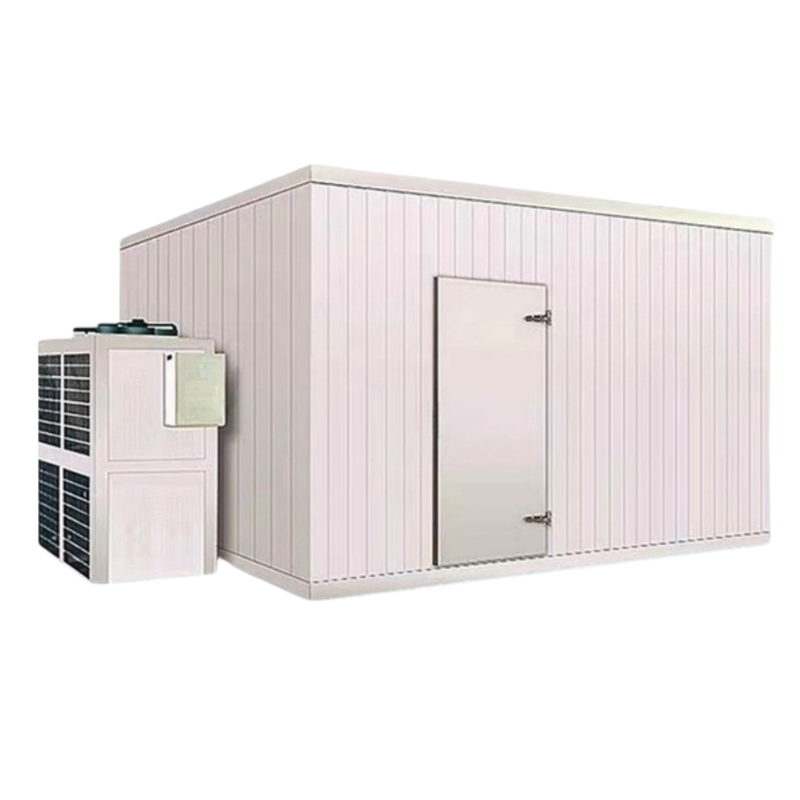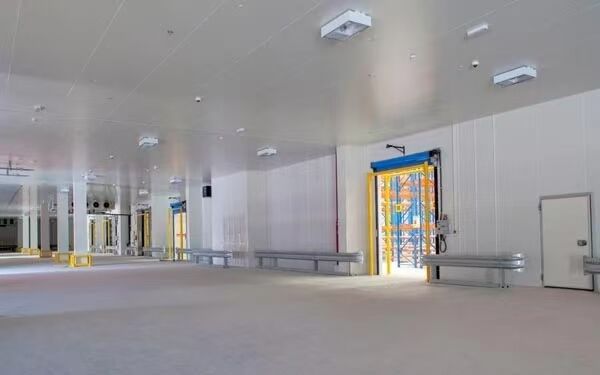Bewerten Sie Ihre Lageranforderungen nach Produktart und Temperatursensibilität
Identifizieren Sie die Arten von Produkten, die benötigen kühlraum aufbewahrung
Die erste Maßnahme beim Einrichten von Kühlsystemen ist die Erstellung einer Liste aller Gegenstände, die gekühlt werden müssen. Die meisten Kühlräume sind mit Lebensmitteln wie Milchprodukten, Fleisch, Obst und Gemüse gefüllt. Heutzutage benötigen jedoch nicht nur Lebensmittel ausreichend Kühlraum. Impfstoffe, biologische Materialien und verschiedene industrielle Verbindungen erfordern ebenfalls eine sorgfältige Temperaturüberwachung. Betreiber von Kältespeichern sollten den Unterschied zwischen normalen Kühlschranktemperaturen von etwa 0 bis 4 Grad Celsius und Gefrierbedingungen kennen, die etwa bei minus 18 bis minus 25 Grad liegen. Diese Temperaturanforderungen beeinflussen direkt, welcher Kühllösungsaufbau für unterschiedliche Anwendungen am besten geeignet ist.
Temperatursensibilität und optimale Bereiche für verderbliche Güter verstehen
Milchprodukte verderben irreversibel bei Temperaturen über 4°C, während Impfstoffe wie mRNA-Formulierungen an Wirksamkeit verlieren, wenn sie Temperaturen außerhalb des Bereichs von 2°C bis 8°C ausgesetzt werden. Eine Studie aus dem Jahr 2023 ergab, dass 63 % der Temperaturabweichungen bei verderblichen Gütern während der Beladevorgänge auftreten, was die Notwendigkeit von Pufferzonen in der Nähe von Zugangspunkten unterstreicht.
Häufige Temperaturbereiche für Lebensmittel, Arzneimittel und Chemikalien abbilden
| Produktkategorie | Temperaturbereich | Maximaler Toleranzbereich |
|---|---|---|
| Frisches Obst und Gemüse | 0°C bis 4°C | ±1°C für 2 Stunden |
| Impfstoffe | 2°C bis 8°C | ±0,5°C (rund um die Uhr überwacht) |
| Industrielösungsmittel | -15°C bis -10°C | ±3°C vor Eintritt der Flüchtigkeit |
Mehrproduktanlagen setzen häufig Zoneneinteilungen ein, wobei laut Daten zur Kühlkettenlogistik 71 % der optimierten Kühllager mindestens drei unterschiedliche Klimazonen nutzen.
Analysieren Sie Fallstudien: Temperaturschwankungen, die zu Verderb bei der Lagerung von Milchprodukten führen
Eine regionale Milchgenossenschaft verzeichnete einen Verlust von 19 % beim Gewinnmarge, als ihre +3 °C kühlraum auf +6 °C während der Spitzenlast im Sommer anstiegen. Später zeigte die Thermografie, dass unzureichende Türdichtungen für 83 % des Wärmeeintrags verantwortlich waren – ein vermeidbares Problem durch ordnungsgemäße Inbetriebnahme der Kühlräume.
Bestimmen Sie Kapazität und Skalierbarkeit für die langfristige Wirtschaftlichkeit einer Kühlkammer

Berechnen Sie den aktuellen Bedarf an Lagervolumen mithilfe von Europaletten- und Regalmetriken
Die genaue Ermittlung der Lagerkapazität beginnt damit, herauszufinden, wie viel tatsächlich in das Lager passt. Wenn beispielsweise ein Lebensmittelunternehmen etwa 200 standardgroße Paletten (ca. 1,2 Meter mal 1 Meter) lagert, benötigt es bei Berücksichtigung der notwendigen 0,5-Meter-Abstände zwischen den Regalen für den Zugang etwa 300 Kubikmeter. Die meisten Experten empfehlen, etwa 40 % zusätzlichen Platz zusätzlich zu dem unmittelbar benötigten einzuplanen. Diese Reserve erleichtert das Umräumen von Gütern und sorgt für eine angemessene Luftzirkulation im gesamten Gebäude. Interessant ist außerdem, dass Unternehmen laut Rinac-Studie des vergangenen Jahres selbst dann, wenn der Platz nicht voll ausgenutzt wird, weiterhin rund 85 bis 90 % ihrer Betriebskosten tragen müssen. Daher ist eine durchdachte Planung unerlässlich, um die Kosten effektiv zu steuern.
Berücksichtigung saisonaler Nachfrage und Prognosen zur Geschäftsentwicklung
Unternehmen, die mit unvorhersehbaren Schwankungen des Lagerbestands umgehen müssen, benötigen Kühlhauslösungen, die auch in Hochzeiten funktionieren, ohne Geld für ungenutzte Flächen zu verschwenden. Nehmen wir als Beispiel Fischverarbeitungsbetriebe: Sie benötigen oft etwa 25 bis 35 Prozent zusätzlichen Platz, wenn Feiertage bevorstehen. Auch pharmazeutische Lager stehen vor ähnlichen Herausforderungen und müssen sich auf große Sendungswellen aus klinischen Studien vorbereiten, die manchmal das Doppelte des Normalen betragen. Intelligente Lagerleiter planen bereits bei der Grundrissgestaltung rund 15 bis 20 Prozent zusätzlichen Platz ein. Einige setzen auf bewegliche Wände, sodass sie Bereiche je nach aktuellem Lagerbedarf erweitern oder verkleinern können. Diese Flexibilität erspart später Kopfschmerzen bei unerwarteten Nachfragespitzen.
Abwägung zwischen anfänglicher Investition und langfristigem Nutzen durch skalierbares Design
Modulare Kälterraumsysteme ermöglichen eine kostengünstige Skalierbarkeit, wobei die Erweiterungskosten laut einer Kühltechnikstudie aus dem Jahr 2023 um 18–22 % unter denen herkömmlicher Bauweisen liegen. Wichtige Gestaltungsstrategien umfassen:
- Stufenweise Erweiterung : Hinzufügen von vorgefertigten Paneelen, um die Kapazität innerhalb von 48 Stunden um 30 % zu erhöhen
- Hybrid-Zoneneinteilung : Kombination von -18 °C Tiefkühl lagern mit 2–4 °C gekühlten Bereichen mithilfe beweglicher Trennwände
- Mehrebeniges Regalsystem : Steigerung der Speicherdichte um 40 % durch verstellbare Traversenhöhen
Unternehmen, die diese Ansätze anwenden, senken ihre Umzugskosten bei Betriebserweiterungen um 60 %.
Wählen Sie das optimale Kühlsystem: DX vs. Zentral für Ihre Kühlraum
Verstehen Sie die Vorteile von DX-Systemen für kleine bis mittlere Kälteräume
Für kleine Kühlräume unter 500 Kubikfuß eignen sich Direktverdampfungs- oder DX-Systeme sehr gut, da sie einfacher zu installieren sind und anfänglich weniger kosten. Die Geräte selbst sind kompakt gebaut, sodass das Kältemittel lediglich durch die Verdampferspulen im Inneren fließt. Diese Konfiguration hält die Temperaturen mit einer Schwankung von etwa plus/minus 2 Grad Fahrenheit recht stabil, was ideal für Orte ist, die eine gleichmäßige Kühlung ohne komplexe Systeme benötigen. Denken Sie an kleine Unternehmen wie lokale Lebensmittelgeschäfte oder Apotheken in der Nachbarschaft, bei denen der Platz besonders wichtig ist. Laut branchenüblichen Erkenntnissen sparen solche DX-Anlagen tatsächlich rund 14 Prozent bei den Energiekosten im Vergleich zu größeren zentralen Systemen, wenn man Räume unter insgesamt 1.000 Quadratfuß betrachtet.
Zentrale Systeme für Anwendungen in mehreren Räumen oder im industriellen Bereich bewerten
Einrichtungen, die mehrere verschiedene Temperaturzonen benötigen oder eine Fläche von über 3.000 Quadratfuß abdecken, stellen oft fest, dass sich zentrale Kälteanlagen als lohnende Investition erweisen. Untersuchungen zu zentralen Kühllösungen haben gezeigt, dass diese Wartungsprobleme um rund 37 % reduzieren, da alle Kondensatoreinheiten an einem Ort zusammengefasst werden. Zudem können diese Systeme sowohl Tiefkühlung bei minus 4 Grad Fahrenheit als auch normale gekühlte Lagerräume mit etwa 34 Grad bewältigen. Auch die Zahlen belegen dies: Eine Analyse des Betriebs von pharmazeutischen Lagern im vergangenen Jahr zeigte, dass der Wechsel zu zentraler Kühlung die Energiekosten pro Palette im Vergleich zu herkömmlichen Direktverdampfungsanlagen (DX) um nahezu 20 % senkte. Solche Einsparungen summieren sich langfristig deutlich.
Analyse der Faktoren, die die Kühlleistung beeinflussen
| Faktor | Auswirkung des DX-Systems | Auswirkung des zentralen Systems |
|---|---|---|
| Abtauvorgänge | Manuelle Planung erforderlich | Automatisch basierend auf Luftfeuchtigkeit |
| Umgebungswärme | Auf Umgebungen bis 85 °F begrenzt | Hält Außentemperaturen bis zu 115 °F stand |
| Lastschwankung | ±15 % Kapazitätspuffer | ±25 % adaptive Skalierung |
Thermische Lastberechnungsfehler verursachen 62 % der Effizienzverluste bei Kühlräumen. Eine ordnungsgemäße Isolierung reduziert die Kompressorlaufzeit bei allen Systemtypen um 29 %.
Fallstudie: Brauerei wechselt von Direktverdampfung (DX) auf zentrales System und senkt Energieverbrauch um 22 %
Eine Craft-Brauerei im mittleren Westen der USA senkte ihre jährlichen Energiekosten von 38.000 $ auf 29.600 $, nachdem sie auf ein zentrales System umgestellt hatte. Die Modernisierung ermöglichte die gleichzeitige Kühlung von Gärbehältern (45 °F) und Fasslagerung (33 °F) sowie die Bewältigung einer um 30 % erhöhten Produktionslast im Sommer. Die Amortisationszeit für die 110.000 $-Investition betrug 3,2 Jahre durch kombinierte Energieeinsparungen und reduzierte Ausfallzeiten.
Maximieren Sie die Energieeffizienz durch Isolierung und Temperaturregelung
Vergleich der Isolierleistung von PUF-, EPS- und Phenolharz-Paneelen
Kühlräume nutzen heutzutage typischerweise drei Hauptarten von Dämmmaterialien: Polyurethan-Schaum (kurz PUF), expandiertes Polystyrol (EPS) und phenolische Platten. Jedes dieser Materialien hat eigene Stärken, wenn es darum geht, Kühlung sicherzustellen. PUF zeichnet sich durch eine besonders geringe Wärmeleitfähigkeit von nur 0,022 W/mK aus und wird lückenlos eingebaut, was es ideal für Orte macht, an denen die Feuchtigkeitskontrolle entscheidend ist. EPS hingegen spart zunächst Kosten, da es etwa 20 bis 30 Prozent günstiger als PUF ist, allerdings müssen Installateure bei hoher Luftfeuchtigkeit Dampfsperren einbauen. Phenolische Platten sind interessant, weil sie im Vergleich zu den meisten anderen Materialien bessere Brandschutzeigenschaften aufweisen (sie verfügen über die Brandklasse O), obwohl sie relativ dünn sind. Zudem zeigen Tests, dass sie ihre isolierende Wirkung bei Temperaturen unter dem Gefrierpunkt 15 % länger beibehalten als EPS.
Dämmstoffdicke mit U-Werten und der Reduzierung von Wärmebrücken verknüpfen
Beim Vergleich der Dämmeigenschaften verbraucht eine Standard-PUF-Platte mit 10 cm Dicke und einem U-Wert von etwa 0,22 W pro Quadratmeter Kelvin tatsächlich rund 38 % mehr Energie als das gleiche Material in 15 cm Dicke (das einen besseren U-Wert von 0,15 aufweist). Dies macht sich besonders in extrem kalten Lagerräumen bemerkbar, in denen die Temperaturen unter den Gefrierpunkt sinken. Das Problem verschärft sich zudem an den Verbindungsstellen zwischen den Platten. Dort kann Wärmebrückenbildung für 12 bis 18 Prozent aller Energieverluste verantwortlich sein. Glücklicherweise haben Hersteller Lösungen entwickelt, wie beispielsweise Nut-und-Feder-Verbindungen, die sich engfügig zusammenfügen, sowie durchgehende Isolierumhüllungen, die dabei helfen, diese Lücken abzudichten. Betrachtet man die Entwicklungen in der Branche, so verringert die Umstellung von üblichen 100 mm dicken phenolischen Platten auf dickere 150 mm-Versionen die unerwünschte Wärmezufuhr in Anlagen bei Außentemperaturen über 30 Grad Celsius um etwa 27 %. Das ist auch logisch, da dickere Dämmung einfach effektiver dabei ist, Räume je nach Bedarf kühl oder warm zu halten.
Energieeinsparungen quantifizieren: 4-Zoll- vs. 6-Zoll-Platten in Anlagen mit hohem Nutzungsaufkommen
Eine Studie aus dem Jahr 2023 an 12 Schlachthöfen zeigte, dass Kühlräume mit 6-Zoll-PUF-Schalen im Vergleich zu 4-Zoll-Ausführungen 18 % (4.200 $/Jahr) an Energiekosten einsparten. Anlagen, die bei -25 °C betrieben wurden, reduzierten Abtauvorgänge um 31 % und verringerten die Kompressorlaufzeit um täglich 1,8 Stunden. Die Amortisationsdauer für eine Dämmungsaufrüstung betrug in Szenarien mit hohem Nutzungsaufkommen durchschnittlich 2,7 Jahre.
Digitale Thermostate und Fernüberwachung für präzise Steuerung von Kühlräumen integrieren
Moderne Kührraumsysteme kombinieren heute IoT-fähige Thermostate (±0,3 °C Genauigkeit) mit automatisierten Warnmeldungen bei Temperaturabweichungen. Einrichtungen, die prädiktive Abtaualgorithmen nutzen, verzeichnen 15–20 % geringeren Energieverbrauch, während cloudbasierte Überwachung durch Echtzeitanpassungen 92 % der Verderbnisvorfälle verhindern. Diese Technologien ergänzen eine robuste Dämmung, um in 98 % der Betriebsstunden eine Stabilität von ±0,5 °C sicherzustellen.
Arbeitsabläufe effiziente Layouts planen und Gesamtbetriebskosten berechnen

Optimierung der Zugangspunkte und der Türplatzierung für eine reibungslose Logistik
Durch eine intelligente Platzierung von Türen kann der Weg zwischen Menschen und Geräten verkürzt werden. Wenn man Lagerplätze einrichtet, ist es sinnvoll, Türen entlang der Zulassungs- und Auslieferungsstellen zu verlegen, um einseitige Wege zu schaffen, damit die Leute nicht ständig in entgegengesetzte Richtungen aufeinander stoßen. Große Lager, die mit viel Produktbewegung zu tun haben, sollten die Installation dieser schnellen Rolltüren in Betracht ziehen, die die Temperaturen gleich halten, aber dennoch das Personal den ganzen Tag schnell rein und raus lassen. Laut einer Studie des "Warehousing Education and Research Council" sparen Unternehmen, die ihre Layout-Konstruktion überdenken, etwa 19 Prozent an Arbeitskosten, weil die Arbeiter weniger Zeit damit verschwenden, zwischen den Bereichen hin und her zu gehen.
Planung von Regalen und Regalsystemen für die Produktrotation und die Zugänglichkeit
Verwenden Sie verstellbare Palettenregale für eine gemischte Lagerhaltung, um die Einhaltung des FIFO-Prinzips (First In, First Out) bei verderblichen Gütern sicherzustellen. Reservieren Sie 20–30 % des vertikalen Raums für saisonale Schwankungen des Lagerbestands. Nutzen Sie Kragarmregale für überdimensionierte Artikel wie z. B. durchgezogene Fleischwaren oder Blumenarrangements und gewährleisten Sie Gänge von 18–24" Breite für die Manövrierfähigkeit von Gabelstaplern.
Wählen Sie rutschfeste Bodenbeläge, die den GMP- und ISO-Normen entsprechen
Wählen Sie Epoxidharz-beschichtete Böden mit Diamantnutprofil (≥ 0,5 mm Rauhigkeit) für Kühlräume mit Betriebstemperaturen unter -10 °C. Für die pharmazeutische Lagerung spezifizieren Sie FDA-konforme Materialien, die glykolbasierten Reinigungsmitteln widerstehen. Integrieren Sie beheizte Bodenzonen in der Nähe von Türen, um Eisbildung zu verhindern – besonders wichtig in Anlagen mit einer Luftfeuchtigkeit von über 85 %.
Gliedern Sie Wartungs-, Energie- und Compliance-Kosten in die Gesamtbetriebskosten ein
Eine umfassende TCO-Analyse für einen 500 m² großen Kühlraum ergibt:
| Kostenfaktor | prognose über 10 Jahre | Optimierungsstrategie |
|---|---|---|
| Energieverbrauch | $142,000 | Kompressoren mit variabler Drehzahl |
| Abtauvorgänge | $38,000 | Bedarfsbasierte Planung |
| Regulatorische Audits | $16,500 | Automatisierte Aufzeichnungssysteme |
Diese Kennzahlen verdeutlichen, warum eine integrierte Layoutplanung die Lebenszykluskosten im Vergleich zu stückweisen Konzepten um 31 % senkt.
Häufig gestellte Fragen
Wie ermittelt man den Speicherbedarf für verschiedene Produkttypen?
Die Identifizierung der Produktarten und ihrer Temperatursensibilität ist entscheidend. Erstellen Sie eine Liste aller Artikel, die Kühlung benötigen, und kategorisieren Sie diese nach ihren Kühlanforderungen, beispielsweise Milchprodukte, Fleisch, Impfstoffe oder industrielle Verbindungen. Die Kenntnis der jeweils erforderlichen Temperaturbereiche hilft bei der Auswahl der geeigneten Kühllagerkonfiguration.
Welche Vorteile bieten modulare Kühllagersysteme?
Modulare Kühllagersysteme bieten kosteneffiziente Skalierbarkeit und ermöglichen eine Erweiterung durch vorgefertigte Paneele. Unternehmen können so ihre Kapazität innerhalb von 48 Stunden schnell um 30 % erweitern, ohne größere Unterbrechungen oder hohe Kosten zu verursachen, was sie zu einer sinnvollen Wahl für langfristige Investitionen macht.
Worin unterscheiden sich Direktverdampfungsanlagen (DX) von zentralen Kälteanlagen?
DX-Systeme eignen sich am besten für kleinere Kühlräume, da sie einfach zu installieren und zu warten sind. Sie halten stabile Temperaturen aufrecht und sind energieeffizient für Räume unter 1.000 Quadratfuß. Zentrale Systeme sind besser geeignet für Anlagen mit mehreren Temperaturzonen und können die Wartungskosten bei großen Flächen erheblich senken.
Welche Rolle spielt die Isolierung bei der Effizienz von Kühlräumen?
Die Isolierung ist entscheidend für die Energieeffizienz von Kühlräumen. Die Dicke von Isoliermaterialien wie PUF, EPS und Phenolharzplatten beeinflusst die Wärmeleitung. Dickere Isolierplatten helfen, den Energieverbrauch durch Minimierung des Wärmeaustauschs zu reduzieren, was für die Aufrechterhaltung der Effizienz entscheidend ist.
Wie können Unternehmen die Energieeffizienz in Kühlräumen maximieren?
Die Implementierung digitaler Thermostate und Fernüberwachungssysteme ermöglicht eine präzise Temperaturregelung und warnt bei Abweichungen. In Kombination mit einer effektiven Isolierung reduzieren diese Technologien den Energieverbrauch und verhindern Verderb, wodurch die Betriebsstabilität sichergestellt wird.
Inhaltsverzeichnis
-
Bewerten Sie Ihre Lageranforderungen nach Produktart und Temperatursensibilität
- Identifizieren Sie die Arten von Produkten, die benötigen kühlraum aufbewahrung
- Temperatursensibilität und optimale Bereiche für verderbliche Güter verstehen
- Häufige Temperaturbereiche für Lebensmittel, Arzneimittel und Chemikalien abbilden
- Analysieren Sie Fallstudien: Temperaturschwankungen, die zu Verderb bei der Lagerung von Milchprodukten führen
- Bestimmen Sie Kapazität und Skalierbarkeit für die langfristige Wirtschaftlichkeit einer Kühlkammer
-
Wählen Sie das optimale Kühlsystem: DX vs. Zentral für Ihre Kühlraum
- Verstehen Sie die Vorteile von DX-Systemen für kleine bis mittlere Kälteräume
- Zentrale Systeme für Anwendungen in mehreren Räumen oder im industriellen Bereich bewerten
- Analyse der Faktoren, die die Kühlleistung beeinflussen
- Fallstudie: Brauerei wechselt von Direktverdampfung (DX) auf zentrales System und senkt Energieverbrauch um 22 %
-
Maximieren Sie die Energieeffizienz durch Isolierung und Temperaturregelung
- Vergleich der Isolierleistung von PUF-, EPS- und Phenolharz-Paneelen
- Dämmstoffdicke mit U-Werten und der Reduzierung von Wärmebrücken verknüpfen
- Energieeinsparungen quantifizieren: 4-Zoll- vs. 6-Zoll-Platten in Anlagen mit hohem Nutzungsaufkommen
- Digitale Thermostate und Fernüberwachung für präzise Steuerung von Kühlräumen integrieren
-
Arbeitsabläufe effiziente Layouts planen und Gesamtbetriebskosten berechnen
- Optimierung der Zugangspunkte und der Türplatzierung für eine reibungslose Logistik
- Planung von Regalen und Regalsystemen für die Produktrotation und die Zugänglichkeit
- Wählen Sie rutschfeste Bodenbeläge, die den GMP- und ISO-Normen entsprechen
- Gliedern Sie Wartungs-, Energie- und Compliance-Kosten in die Gesamtbetriebskosten ein
-
Häufig gestellte Fragen
- Wie ermittelt man den Speicherbedarf für verschiedene Produkttypen?
- Welche Vorteile bieten modulare Kühllagersysteme?
- Worin unterscheiden sich Direktverdampfungsanlagen (DX) von zentralen Kälteanlagen?
- Welche Rolle spielt die Isolierung bei der Effizienz von Kühlräumen?
- Wie können Unternehmen die Energieeffizienz in Kühlräumen maximieren?

